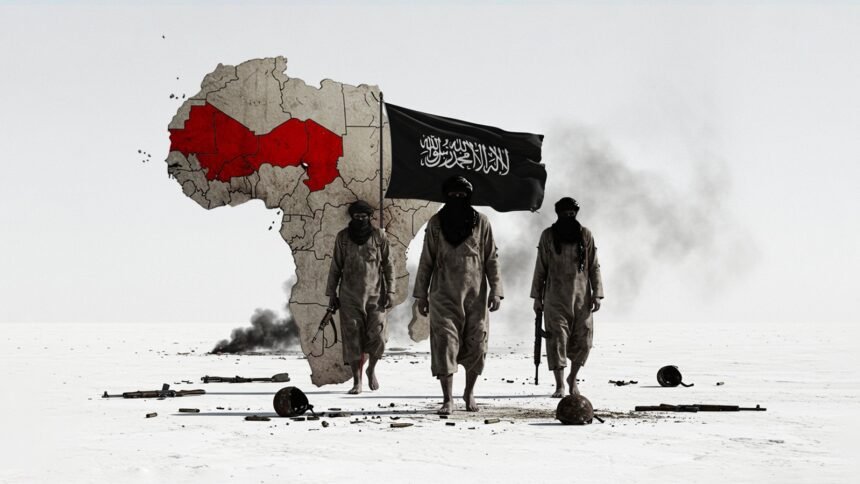Ouagadougou — For a region already teetering on the edge of collapse, the return of al-Qaeda’s black banner isn’t a plot twist—it’s a sequel no one asked for. Jama’at Nusrat al-Islam wal-Muslimin (JNIM), the al-Qaeda franchise operating across Mali, Burkina Faso, and Niger, is back in headlines and back in business. After a brief lull following intensified counterterrorism operations, the group has come roaring back with a chilling string of attacks aimed at both military targets and civilians.
In a stunning escalation, the group carried out a coordinated assault on a Malian army base in Boulkessi on June 1, killing over 100 soldiers and seizing weapon stockpiles. This was not a hit-and-run. It was a calculated show of force, one designed to signal that JNIM is no longer lurking in the shadows. It is out in the open, emboldened and armed, with a clear territorial vision. In fact, more than 400 soldiers across the Sahel were killed in May and June alone—many of them in ambushes that suggest the group has mastered not just brutality, but strategy.
The timing of this resurgence is hardly coincidental. Mali, Burkina Faso, and Niger—all now under military juntas—have shifted their alliances away from France and toward Russia and regional self-reliance. In the process, foreign troops have withdrawn, intelligence sharing has shrunk, and state cohesion has further deteriorated. Where once a French drone might have hovered, now there is often nothing but empty sky and an open road—for jihadists to claim.
Local governments have responded with a mix of denial, bravado, and information blackouts. Mali’s military-led government downplayed the Boulkessi assault, initially calling it “an isolated terrorist incursion.” Social media, however, told a bloodier story. Graphic images and amateur videos circulated showing entire units wiped out and military posts in flames. Burkina Faso and Niger have similarly suppressed coverage, eager to project strength even as their rural territories slip through their fingers.
But JNIM isn’t just targeting soldiers. Civilian massacres are also increasing, especially in contested zones where state presence is minimal. In northern Burkina Faso, villages suspected of cooperating with the military are being burned to the ground. Human rights groups estimate that more than 5,000 civilians have been displaced in recent weeks. Market days are cancelled. Schools remain shut. Government offices are abandoned by nightfall. The jihadist message is simple: we’re the ones in charge now.
What sets JNIM apart from other jihadist outfits—such as ISIS affiliates in the region—is its more nuanced approach to territorial control. The group has reportedly engaged in local mediation, sometimes even offering dispute resolution mechanisms in areas where state justice systems are absent. While this may sound like a twisted PR campaign, it’s dangerously effective. In zones of chronic state neglect, JNIM is positioning itself not just as a violent disruptor but as an alternative authority.
This pseudo-governance strategy echoes al-Qaeda’s approach in Yemen and parts of Syria. By embedding itself within communities, avoiding spectacularly indiscriminate violence, and exploiting real grievances against corrupt or absent governments, JNIM is laying the foundation for what analysts now call “caliphate 2.0”—not a blitzkrieg-style Islamic State conquest, but a slow-motion, community-by-community expansion.
The international response has been, at best, fragmented. The United Nations has issued the usual statements of concern. The United States has focused more on containing Russian influence in the Sahel than addressing the jihadist surge. France, burned by years of military losses and anti-French sentiment, is largely out of the picture. Meanwhile, the newly formed Alliance of Sahel States (AES), composed of Mali, Niger, and Burkina Faso, insists it is handling the crisis—despite mounting casualties and shrinking territory.
There is talk of reviving joint security efforts like the G5 Sahel force, but trust is low and resources are scarcer. Most tragically, regional cooperation is being undercut by geopolitics. Where there should be a coordinated effort to counter jihadist insurgency, there is suspicion between juntas, diplomatic rifts with ECOWAS, and a pervasive sense that the international community has moved on.
But for the people of the Sahel, there is no moving on. A teacher in Gao, Mali, described the current reality with chilling simplicity: “If you hear a car after 5 p.m., you don’t ask who it is. You run.” Markets now close before noon. Farmers work in pairs, one tilling soil while the other watches the horizon. Villages once known for their hospitality now warn strangers to leave before nightfall.
As the black flags rise again, many in the region feel abandoned—not just by their governments, but by the world. The fight against terrorism in the Sahel was never truly won; it was merely postponed. And now, with power vacuums and political chaos opening new doors, JNIM has walked back in without even having to knock.
The Sahel may not be lost, but it’s in retreat. And unless regional and global powers wake up to the scale of the threat, the next time the world pays attention might be after the next massacre—not before it.










